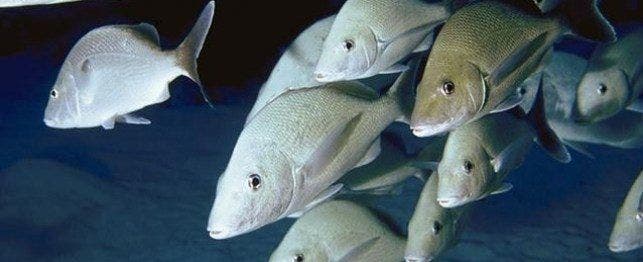
Why Fish Swim in Schools
Everyone knows the joke: Why are fish smart? Because they’re always in schools. Around the reefs thousands of schooling silversides dart back and forth, all in unison, seemingly to some internal melody that only the fish can hear. They turn, rise, and dive, and not a single fish misses a beat. It’s one of nature’s most beautiful ballets. Can you re-create it in your aquarium? The answer is yes, especially if you dive a little deeper into the schooling riddle.
Fish travel in schools because they are programmed by evolution to know that safety lies in numbers. Should a hungry predator approach the group, the first line of defense begins with the many confusing silvery flashes or mesmerizing stripes that make it difficult to focus on a single fish. Schools also seem to make finding food an easier task. And some fish schools are more like street gangs, patrolling their territory and running out any trespassing intruder.
How Fish Swim in Schools
The advantages that a school lends to an individual seem logical, but more magical is how each fish seems to know exactly where everyone else is going and at exactly the same time. Although most fish school primarily by using their vision, nature has given them a little help. Fish can sense water displacement with a system of hair-like receptors similar to those in the human inner ear.
Tightly packed bundles of protruding hairs, called a neuromasts, encased in a jelly-like sheath, are scattered around the head and body. Most are concentrated in two canals along the sides of the fish called lateral lines, which run from the head to the base of the tail. With the slightest change in pressure, the tiny hairs bend. The fish senses the movement of the objects around it, and quickly responds.
Meanwhile, there is constant unrest within the school. The fish chase and nip at each other as they vie for a spot close to the center of the group, where it is the safest. This nipping doesn’t pose too much of a problem in nature because too many fish make up a natural community for any single fish to be affected. But in your aquarium, keeping schooling fish calls for some special considerations.
Secret to Keeping Schooling Fish
If a pair of schooling fish are kept in a community tank, one of them will eventually begin to dominate, nipping at its companion’s fins, pursuing it mercilessly and bullying it to the point of exhaustion. To find relief, the weaker fish is often forced to hide, especially during mealtimes. After a short time of such torment, the weaker of the two commonly succumbs to disease and inevitably dies. But having only one of a kind does little to solve the problem. The inherently social fish may seem lonely, keeping to itself in a corner or hiding most of the time. Or, it may attempt to play with its tank-mates of another kind, terrifying them or damaging their fins.
The fix is a matter of numbers. Schooling fish like danios, barbs, tetras, tangs and wrasses, seem to behave themselves much better in a community tank if they are in a group of at least four, rather than just a pair. Depending on your tank size, a dozen or so will make for a spectacular display. They will dart around the tank giving your aquarium a boost of color and motion.